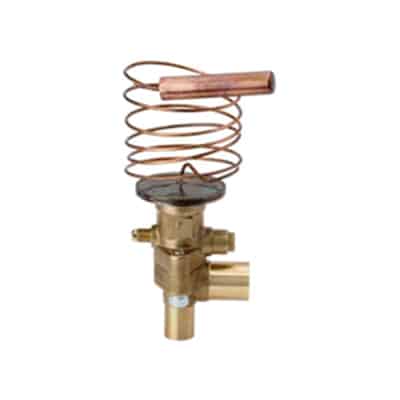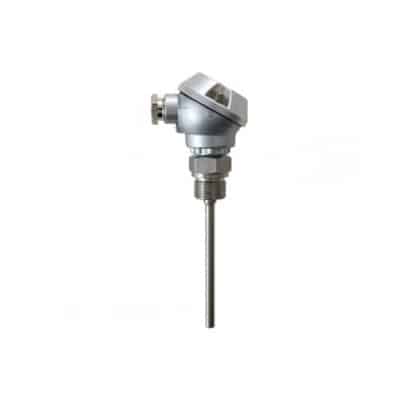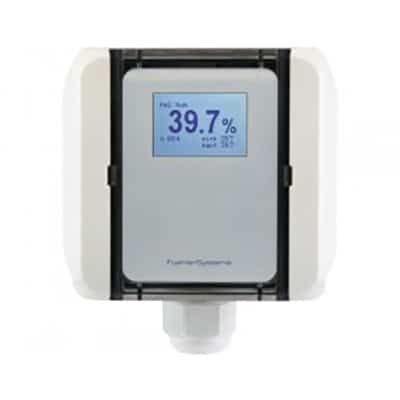Exchangeable Power Assemblies and Orifices
- Modular design for economical logistics and easy assembly and servicing
- Very good stability due to large diaphragm diameter
- Constant superheat across a wide application range
- Superior partial load performance due to double seat orifice design (TJRE,TERE, TIRE & THRE)
- Bi-flow capability for applications in heat pumps
- Capillary tube length 1.5 m (TCLE, TJRE) and 3m (TERE, TIRE & THRE)
Max. allowable pressure PS:
- - 46 bar with XB power assembly
- - 31 bar with XC power assembly
- Medium Temperature range TS: -45…+75°C
- Flanges: brazing ODF/ODM connection
Basic Terms and Technical Information Operating Principles
Alco Thermo-Expansion valves control the superheat of refrigerant vapor at the outlet of the evaporator. They act as a throttle device between the high pressure and the low pressure sides of refrig- eration systems and ensure that the rate of refrigerant flow into the evaporator exactly matches the rate of evaporation of liquid refrigerant in the evaporator. Thus the evaporator is fully utilized and no liquid refrigerant may reach the compressor.
Description of Bulb Charges
The application ranges of Thermo-Expansion valves are heavily influenced by the charge selected.
Liquid Charges
The behaviour of Thermo-Expansion valves with liquid charges is exclusively determined by temperature changes at the bulb and not subject to any cross-ambient interference. They feature a fast response time and thus react quickly in the control circuit. Liquid charges cannot incorporate MOP functions. Maximum bulb temperatures shall not exceed 75°C.
Gas Charges
The behaviour of Thermo-Expansion valves with gas charges willbe determined by the lowesttemperature atany part of theexpansion valve (power assembly, capillary tube or bulb). If any parts other than the bulb are subject to the lowest temperature, malfunction of the expansion valve may occur (i.e., erratic low pressure or excessive superheat). Alco Thermo-Expansion valves with gas charges always feature MOP functions and include ballasted bulbs. Ballast in the bulb leads to slow opening and fast closure of the valve. Maximum bulb temperature is 120°C.
Adsorption Charges
These charges feature control characteristics much like MOP charges but avoid the difficulties of cross-ambient interference. Response time is slow but perfectly suitable for common refrigerationsystems. Maximum bulb temperature is 130°C.
MOP(Maximum Operating Pressure)
MOP functionality is somewhat similar to the application of a crankcase pressure regulator. Evaporator pressures are limited to a maximum value to protect compressor from overload conditions. MOP selection should be within maximum allowed low pressure rating of the compressor and should be at approximately 3K above evaporating temperatures.
Practical hint: superheat adjustments influence the MOP: Increase of superheat: Decrease of MOP Decrease of superheat: Increase of MOP
Static Superheat
Alco Thermo-Expansion valves are factory preset for optimum su- perheat settings. This setting should be modified only if absolutely necessary. The readjustment should be at the lowest expected evaporating temperature.
Subcooling
Subcooling generally increases the capacity of the refrigeration system and may be accounted for when dimensioning an expansionvalve by applying the correction factor K t.The capacity
corrections forevaporatingtemperature,condensingtemperature
and subcooling are all incorporated in K t. These are, in particular the liquid density upstream from the expansion valve, the different enthalpies of liquid and vapor phase refrigerants, as well as certain parts of flash gas after expansion. The percentage of flash gas differswithvarious refrigerantsanddependson systemconditions.
Heavy subcooling results in very small flash gas amounts and therefore increases expansion valve capacities. These conditions are not covered by Kt. Likewise, small flash gas amounts lead to reduced evaporator capacities and may result in substantial discrepancies between the capacities of the Thermo-expansion valve and the evaporator. These effects have been integrated in selection program “Controls Navigator”.
Dimensioning
To facilitate valve dimensioning for other than standard conditions, Emerson offers the “Controls Navigator” selection tool which can be downloaded from climate.emerson.com/en-gb.
Dimensioning of Thermo™ - Expansion Valves for Systems with Refrigerant Having Temperature Glide
As opposed to single substances (e.g. R 134a) where the phase change takes place at a constant temperature/pressure the evaporationand condensation of zeotropic blends are in a ”gliding” form (e.g. at a constant pressure the temperature varies within a certain range) through evaporators and condensers. HFO blends R448A and R449A are zeotropic blends.
The condensing /evaporating pressure must be determined at saturated temperatures (bubble for liquid /dew points for vapor) for dimensioning of the expansion valves, solenoid valves etc. The corresponding dew point for liquid pressures is provided in case of compressor selection based on dew point of liquid pressure.






